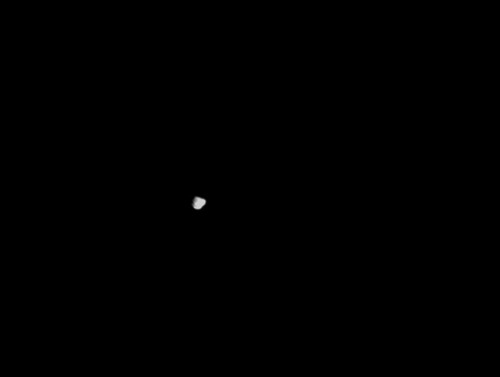We’re starting to get a look at imagery from the Stardust spacecraft’s close approach to comet Tempel 1, which occurred this morning at about 0439 UTC (2339 EST). The mission is an extension for the comet-chasing spacecraft, which flew past comet Wild 2 in 2004 and collected samples from the cometary coma that were subsequently returned to Earth. This time we’re returning to a previously visited comet, the site of the Deep Impact spacecraft’s encounter in 2005. You’ll recall that on that mission, an impactor was driven into the comet. Scientists are interested in learning what changes have occurred in the interval between visits, and possibly examining the crater.

Image: NASA’s Stardust-NExT mission transmitted the first image it took during its approach to comet Tempel 1 at 8:35 p.m. PST (11:35 p.m. EST) on Feb. 14, 2011, from a distance of approximately 2,462 kilometers (1,530 miles). The comet was first visited by NASA’s Deep Impact mission in 2005. Credit: NASA/JPL-Caltech/Cornell.
Where are the close-ups? What we know from preliminary data transmitted from the spacecraft is that the closest approach was to a distance of 181 kilometers. At about 0600 UTC, Stardust turned its high-gain antenna at the Earth and began the data downlink that should return the rest of the images later today. We’re expecting 72 images from Tempel 1, but the downloading process hasn’t gone as planned, with the images of the closest approach still aboard Stardust in a glitch that at this point doesn’t seem to threaten the loss of any data. We should know more when a NASA news conference, delayed from 1800 UTC (1300 EST), takes place later in the day.
Later: The images are coming in; here’s a sample. For more, check here.
Image: NASA’s Stardust-NExT mission took this image of comet Tempel 1 at 8:39 p.m. PST (11:39 p.m. EST) on Feb 14, 2011. Stardust-NExT is a low-cost mission that will expand the investigation of comet Tempel 1 initiated by NASA’s Deep Impact spacecraft. JPL, a division of the California Institute of Technology in Pasadena, manages Stardust-NExT for the NASA Science Mission Directorate, Washington, D.C. Joe Veverka of Cornell University, Ithaca, N.Y., is the mission’s principal investigator. Lockheed Martin Space Systems, Denver, built the spacecraft and manages day-to-day mission operations. Credit: NASA/JPL-Caltech/Cornell.




Shades of Mariner 4 when it flew by Mars in 1965. Its 22 hhistoric – if not exactly perfect – images took several weeks to be sent back to Earth at 8 bits per second!
http://nssdc.gsfc.nasa.gov/imgcat/html/mission_page/MR_Mariner_4_page1.html
Oh well, Stardust-NeXT was a bargain mission that might not have happened for a long time or at all otherwise. It will be interesting to see if the crater Deep Impact’s 800-pound copper made is as deep as a 7-story building as they predicted. Then again, they also didn’t predict all the fine dust that would be kicked up and block the view of the crater fhe first time. :^)
The 72 images are coming in slowly but surely, as you can see here:
http://www.jpl.nasa.gov/news/stardust/
The Deep Impact crater is probably that little white “dot” between the two natural craters. Apparently it was expected to be bigger than it seems. We certainly are learning a lot about comets from all this. It also seems from preliminary images that the surface of Temple 1 has not changed much if at all in the six years since DI first saw it. At least on this large, distant scale.
Definitely need to land softly on one of these things for indepth examination. Yes, I know about Rosetta and Champolion – which, btw, has a disc containing identical words from over 1,000 human languages courtesy of the Long Now Foundation.
I am always extremely pleased to see data coming back from these “extended mission” opportunities re-using an existing spacecraft asset. This is NASA at its best.
Speaking as an advocate of our future using these chunks of rock and ice as resources, I think building a more robust and extensive set of data on any of these objects is extremely good.
The small white dot was also there before the Deep Impact event, so that’s definitely not the crater we’re looking for.
In fact, there doesn’t seem to be any convincing evidence for an impact crater at all. (are we at the right comet? ;P )
Very surprising results. The surface must be extremely porous.
Compare: http://www.jpl.nasa.gov/images/stardust/stardust2/n30037te01.jpg
to: http://www.nasa.gov/mission_pages/deepimpact/multimedia/composite_map-20061002.html
It looks like Stardust got a good look at the impact point. I don’t see anything notable on the new image but I don’t think these are the full resolution images.
Here is a close-up image of the Deep Impact crater:
http://stardustnext.jpl.nasa.gov/mission/ManMade_Crater_Comet.html
Much more subdued than anticipated. Says a lot about the comet’s makeup.
Late to the party on this one, Paul, but I must share the reaction I had when I read your headline? ‘Delayed images…’ !
The spacecraft is how many thousands of km away? Hasn’t our perspective changed over the last few decades!
More information and images here:
http://www.planetary.org/blog/article/00002920/